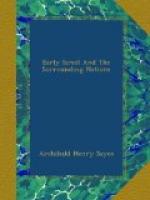In disposition the Egyptian was remarkably kindly. He was affectionate to his family, fond of society, and, alone among the nations of antiquity, humane to others. His laws aimed at saving life and reclaiming the criminal. Diodoros states that punishments were inflicted not merely as a deterrent, but also with a view towards reforming the evil-doer, and Wilkinson notices that at Medinet Habu, where the artist is depicting the great naval battle which saved Egypt from the barbarians in the reign of Ramses III., he has represented Egyptian soldiers rescuing the drowning crew of an enemy’s ship.
The Pharaoh derived his title from the Per-aa or “Great House” in which he lived, and where he dispensed justice. The title thus resembles that of the “Sublime Porte.” Next to him, the priests were the most powerful body in the kingdom; indeed, after the close of the struggle between Khu-n-Aten and the priesthood of Thebes the latter obtained more and more power, until under the kings of the Twentieth dynasty they were the virtual rulers of the state. They stood between the labouring classes and the great army of bureaucracy which from the days of the Eighteenth dynasty onward carried on the administration of the kingdom. The labouring classes, however, knew how to defend their own interests; the artisans formed unions and “went on strike.” Curious accounts have been preserved of strikes among them at Thebes in the time of Ramses III. The free labouring population must be distinguished from the slaves, who were partly negroes, partly captives taken in war. The greater part of the latter were employed on the public works. The mines and quarries were worked by criminals.
At home the well-to-do Egyptian was artistic in his tastes. The walls and columns of his house were frescoed with pictures, and his furniture was at once comfortable and tasteful. Chairs and tables are of patterns which might well be imitated to-day, and the smallest and commonest articles of toilet were aesthetically and carefully made. Nothing can exceed the beauty of the jewellery found at Dahshur, and belonging to princesses of the Twelfth dynasty. Precious stones are so exquisitely inlaid in gold as to look like enamel, and are formed into the most beautiful of designs; small forget-me-nots, for example, alternate with plain gold crosses on one of the coronets, and the workmanship of the pectoral ornaments could hardly be equalled at the present day. In dress, however, the Egyptian was simple; his limbs were not overloaded with jewellery, and he preferred light and muslin-like linen, which was kept as scrupulously clean as his own person.




